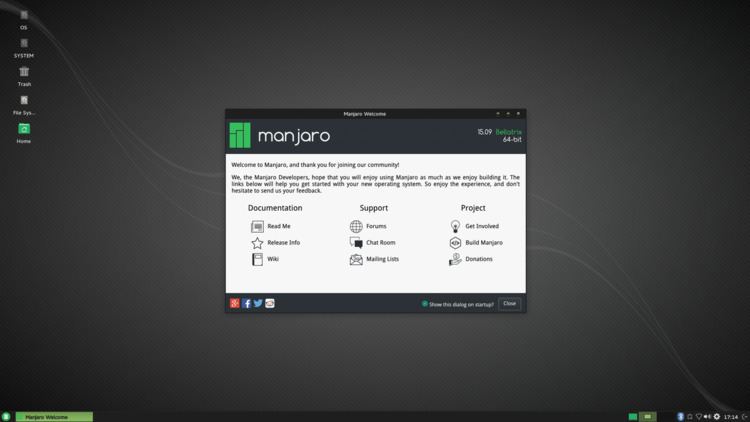OS family Unix-like | Source model Open source | |
 | ||
Developer Guillaume Benoit, Philip Müller Working state Current (Bleeding edge, rolling release) Initial release July 10, 2011; 5 years ago (2011-07-10) Latest release 17.0 Codename "Gellivara" / March 7, 2017; 12 days ago (2017-03-07) | ||
Manjaro Linux /mənˈdʒɑːroʊ lɪnəks/, or simply Manjaro, is a Linux distribution based on Arch Linux. Manjaro Linux is based on the rolling release update model similar to that of Arch Linux and uses pacman as its package manager.
Contents
Relation to Arch Linux
Manjaro Linux is based on Arch Linux and has its own collection of repositories. The distribution aims to be new user-friendly while maintaining the Arch base, most notably the Pacman package manager and compatibility with the Arch User Repositories. Manjaro itself uses three sets of repositories: the unstable repositories contain the most bleeding edge Arch packages, possibly one or two days delayed; the testing repositories contain packages from the unstable repos synced every week, which provides an initial screening; and the stable repositories contain only packages that are deemed stable by the development team.
History
In mid 2013, Manjaro was in the beta stages, though key elements of the final system, such as a GUI installer (currently an Antergos installer fork), a package manager (Pacman) with its choice of frontends Pamac (GTK+) for Xfce desktop and Octopi (Qt) for its Openbox edition, MHWD (Manjaro HardWare Detection, for detection of Free & Proprietary video drivers), and Manjaro Settings Manager (for system wide settings, user management, and graphics driver installation and management) have been implemented.
Release history
The current release of Manjaro Linux is 17.0, codename "Gellivara", which was released on 7 March 2017 and is the sixth version to utilize a build number as the official version instead of a traditional version due to it being a rolling release OS. Manjaro 15.09 was the first stable release after beta stage.
The 0.8.x series releases were the last version of Manjaro to use a version number. The desktop environments offered, as well as the amount of programs bundled into each separate release have varied for different releases.
Xfce, KDE Plasma 5 and GNOME are the currently available official desktop environments. Community supported versions include: E17, MATE, LXDE, Cinnamon, KDE/Razor-qt (a Manjaro Turkey project), the tiling window manager i3, and Fluxbox. Other editions are also available for install in the repos.
GNOME Shell support was dropped with the release of version 0.8.3.; however, efforts within Arch Linux made it possible to restart the Cinnamon/GNOME edition as a community edition.
As of Manjaro 0.8.11, many community editions have been created which include the following: Netbook, Cinnamon, PekWM, Fluxbox, MATE, LXQt, Enlightenment, GNOME and LXDE.
The 0.8.12 release is predominantly a maintenance release and includes very few changes to system defaults relative to the previous 0.8.11 ISOs, with some notable exceptions, such as out-of-the-box support for the exFAT file system and the change to pacman 4.2.
During the development of Manjaro 0.9.0, in the end of August 2015, the Manjaro team decided to switch to year and month designations for the Manjaro version scheme instead of numbers. This applies to both the 0.8.x series as well as the new 0.9.x series, renaming 0.8.13, released in June 2015, as 15.06 and so on. Manjaro 15.09, codenamed Bellatrix and formerly known as 0.9.0, was released on 27 September 2015 with the new Calamares installer and updated packages.
Features
Manjaro Linux comes with both a CLI and a graphical installer. The rolling release model means that the user does not need to reinstall the system to keep it up-to-date. Package management is handled by pacman via command line (terminal), and frontend GUI package manager tools called Pamac (for its default Xfce edition) & Octopi (for its KDE edition). It can be configured to be either a stable system (default) or bleeding edge in line with Arch.
The repositories are managed with their own tool called BoxIt, which is designed like git.
Reception
In January 2013, Jesse Smith of DistroWatch reviewed Manjaro Linux 0.8.3. He noted, "Manjaro does just about everything quickly. The system is light and the Xfce desktop is very responsive. The distribution seems designed with the idea it will stay out of the way as much as possible." Smith ran into problems with updates breaking the installation:
He concluded that the distribution is geared towards experienced Linux users as it requires a great deal of knowledge to install and run.
In July 2014, Jesse reviewed Manjaro Linux again, v0.8.10. In a reversal of his previous impression, he concluded:
Variants
OpenRC was started in June 2014 as a version of Manjaro that omits systemd. Robert Storey of DistroWatch noted, "Manjaro OpenRC is mostly systemd free - it uses ConsoleKit2 instead of logind, and eudev instead of systemd-udev. However, it bundles some of the systemd libraries in a eudev-systemdcompat package, mostly due to how Arch packages systemd."
